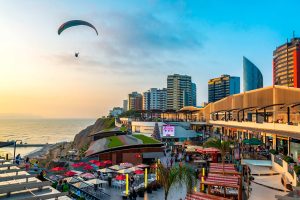Walking the Inca Trail is like following in the footsteps of our ancestors and then entering their imposing buildings such as Wiñay Wayna, a beautiful place that preserves its ancient essence intact.
The archaeological center of Wiñay Wayna means “Forever Young”, and it’s known as the baby Machu Picchu due to its impressive constructions. Its name corresponds to an orchid that’s also abundant in the area. According to Garcilaso de la Vega, this flower was the Inca military emblem.
This Inca city sits on a mountain slope, but in a way that’s blended with nature and respecting the ecology, as was the norm among the Incas.

About Wiñay Wayna
This beautiful Inca construction is 3,600 masl and 5 kilometers southeast of the Machu Picchu citadel. The climate in this region is subtropical. You can only see this site by doing the Inca trail.
The architecture at Wiñay Wayna is the same as that apparent in Machu Picchu. Because of its location and design, it’s assumed by most that it was the administrative center of the Inca city.
In Wiñay Wayna you’ll see 20 urban areas, religious centers, and zones for agriculture. Several terraces are next to courtyards that connect with all the precincts. Their design and placement suggest that they were administrative dwellings for the Inca nobility. There’s also a 7-window temple in honor of the rainbow.
In addition to the fantastic architecture, Wiñay Wayna boasts ceremonial water fountains. It’s believed by many that the place was used by Incas to meditate. The water ritual was performed with aromatic flowers grown in Phuyupatamarca, which were placed around the site; the Inca sat down and water fell on him from above, which allowed the ruler to enter a state of deep relaxation.

What Was Wiñay Wayna Really?
As mentioned before, one theory states that Wiñay Wayna was an administrative center, due to the structure of its buildings. If this is true, we assume that their enclosures were meant to store crops for the people from Sayaqmarka, Conchamarka, Phuyupatamarca, and Intipata (all archaeological centers today); the latter in Inca times was one of the largest agricultural producers in the region. The administrative work was made up of distributing coca, potatoes, corn, quinoa, and other crops among the communities of the territory adjacent to Machu Picchu.

How Do You Get to Wiñay Wayna?
The only way to visit this archaeological center is by doing the classic 4 day Inca Trail or the short 2 day Inca Trail.
Important fact: The 2 and 4 day Inca Trails can only be done with an authorized tour agency.

Differences Between the Classic Inca Trail and the Short Inca Trail
The main differences between the two treks are the number of days of walking and the amount of attractions that you’ll visit along the way.
On the 4 days classic Inca Trail you get to visit the Inca sites of Kanabamba, Patallaqta, Dead Woman’s Pass, Runkurakay, Phuyupatamarka, Intipata, Wiñay Wayna, Puerta del Sol, and, of course, Machu Picchu
On the short 2-day Inca trail you can visit the attractions of Chachabamba, Wiñay Wayna, Puerta del Sol, and Machu Picchu.
The great thing about both options is that you get to enjoy the archaeological center of Wiñay Wayna, which is the protagonist of this article.











Leave A Reply